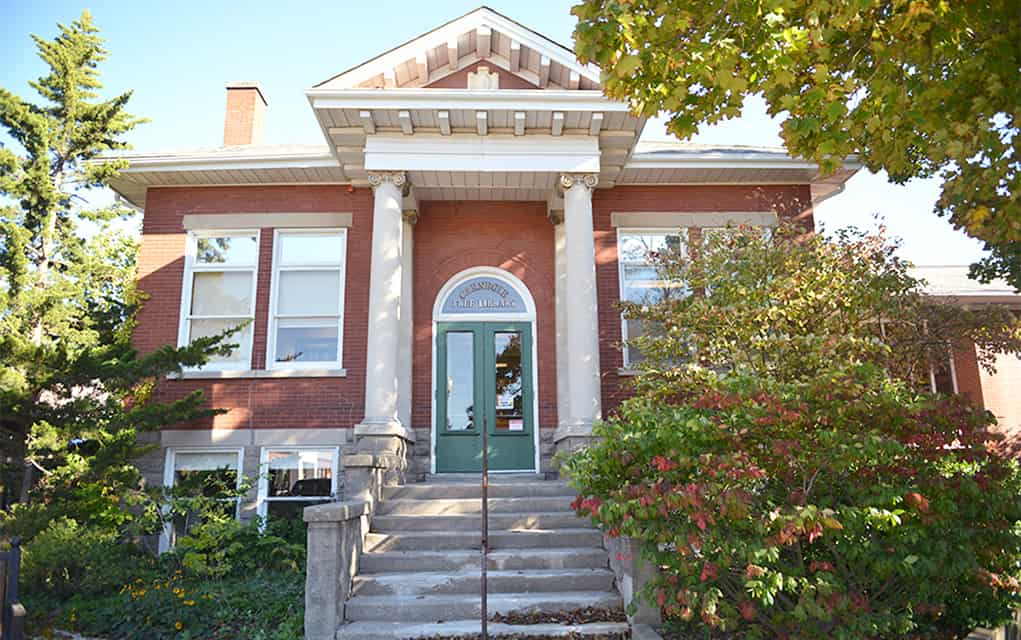Part-time philanthropist, full-time robber baron, Andrew Carnegie lived in a world far removed from Elmira, but there’s a little piece of him to be found there to this very day: just look up over the door when heading into the library.
Born into working-class family in Scotland in 1835, Carnegie would go on to make a fortune in the U.S. steel industry through monopolistic tactics, corruption, and union-busting typical of the oligarchs of his day. He’s remembered these days for this philanthropy in later years, most notably for funding libraries, which he believed were the key to public education – he refused workers’ requests for raises, arguing they were better off with public libraries, for instance.
In his lifetime, Andrew Carnegie donated $56 million to build 2,509 libraries throughout the world. A typical Carnegie grant was about $10,000 – approximately $650,000 in today’s dollars. These funds contributed significantly to the development of small communities around the world, providing much needed services, as well as many spectacular buildings for which many towns and cities are known. Of the 125 Carnegie libraries in Canada, 111 were built in Ontario. In total, Andrew Carnegie spent $2,556,600 on the construction of libraries in Canada.
Though he had plenty of money to share in later years, his life didn’t start that way. Carnegie’s was a real rags-to-riches tale.
“He grew up in Scotland and into poverty,” explained Susan Burke, education coordinator for the Waterloo North branch of Architectural Conservancy Ontario (ACO). “His father was a linen weaver, and they were all doing it by hand at that point. Things started to go downhill; they didn’t seem to have any future there, so they rolled the dice and emigrated to the States. Carnegie was put to work. He was a bobbin boy in the linen trade.”
He went on to become a telegrapher and later invested in bridges, railroads and oil derricks. However, his real fortune was acquired through his co-founding of a steel business, appropriately titled Carnegie Steel Company, in Pittsburgh.
A combination of low wages, efficient organization and technological infrastructure contributed to a massive profit for the business. Carnegie later sold the company to J.P Morgan for $303,450,000 in 1901, making him the wealthiest American for the next few years.
He certainly wasn’t totally selfish with his funds, however, dedicating the next 18 years of his life towards philanthropic works, with a particular focus on education. His motto: “A man who dies rich dies disgraced.”
“When he made all this money, he turned to how he could help other people,” said Burke. “He felt as if anybody who was personally rich had an obligation to distribute wealth to the improvement of mankind.”
The “Andrew Carnegie Dictum” was straightforward, separating life into three distinct sections: spend the first third of one’s life gaining as much education as possible, followed by the second third of your life making as much money as possible. The final third was to be spent giving it all towards worthwhile causes. His massive contribution towards public libraries certainly helped with the first third of his dictum.
Eight Carnegie libraries were built in the Waterloo Region, with three still functioning currently as libraries – Elmira, New Hamburg, and Hespeler. Now part of the Region of Waterloo Library system, the Elmira building opened in 1913 after receiving a $7,000 grant from the Carnegie Foundation.
Though not as grandiose as some, the Elmira building bears the hallmarks of the classic architectural style Carnegie promoted along with the functionality of “open stacks” that allowed the public to browse through the books themselves rather than keeping the books out of reach, accessible only through the librarians.
His approach had a tremendous impact not just on libraries but on the communities themselves. His legacy was the subject of a free lecture last week in Kitchener sponsored by the ACO. Erin Smith, a heritage planner with the city of Brampton, spoke about the ways the libraries have been retrofitted, their unique design, and the broader timeline of architecture and library development. She focussed particularly on the entire period of Carnegie’s grant program from 1903-1923.
She says that before the Carnegie libraries were constructed around the beginning of the 20th century, there was no set precedent for what a library should look like or how it should work.
“Ontario libraries before really lacked the physical structure,” said Smith. “Earlier there were just libraries in people’s homes, or in existing businesses or other buildings that were already in the city. There were personal library collections. After that, there became mechanical institutes and provided more access to more people, but they were simply put wherever they could find space. For example, the one in Waterloo was the town hall.
“It was a transition in establishing a new physical structure for the library. So offering a model answering how a library should look and how it should function. Previous to that, there wasn’t a consensus as to what they should look like and how they should operate.”
The libraries were inspired by beautiful beaux-arts architecture, which drew on principles of French neoclassicism but also incorporated Renaissance and Gothic elements. The structures also included modern materials such as iron and glass.
“It was taught in Paris at the school of Beaux-Arts,” explained Burke. “So they’re very much reflecting back on the classical period. They made a big deal of the entry, so usually, there was a very handsome doorway. Steps leading up to the doorway, and then pillars or plasters around the entry and that triangular piece that looks like it’s being held up by the columns that turn it into a little house of worship. Frequently, the name Carnegie is on it somewhere. His name is quite familiar to people – people that go to libraries.”
Smith, who previously hosted a lecture on Carnegie libraries for Doors Open Waterloo Region, notes that generally it’s the older generation that is more familiar with the work of Carnegie.
“I find it interesting because when I speak to my friends about it – many of them are in their twenties, they might remember Carnegie libraries, but they’re also of the age where they were probably going to the mid-20th-century buildings, including the Waterloo Public Library and Kitchener Public Library.
“The older crowd knows more about it. The younger group is definitely interested in learning more, but they don’t necessarily know who Carnegie was.”
Though examples of Carnegie libraries still exist, some have been repurposed for other uses or even demolished. Among the latter group was the region’s grandest example, the Berlin library, which was demolished in 1962 after being replaced by the much less captivating building now home to the main branch of the Kitchener Public Library.
“In the mid-20th century, there were these paradigm shifts in architecture when we really wanted to demolish what was old and create a new structure,” explained Smith. “So there was this push for massive library structures we saw in Waterloo – the Waterloo Public Library, and the Kitchener Public Library.
“So they were built in that time period when we were shifting away from the Carnegie library. That’s when a lot of them were demolished; that’s when the Berlin Carnegie Library was demolished, during that time period.”
Such losses help make the surviving Carnegie libraries of greater historical significance.
“I think the reason behind the fact that many of them are still existing, they remind us of our community’s commitment to having public access to information,” said Smith. “The buildings themselves do an outstanding job of reflecting what our early 20th century notions of what a library form and function were. So I think that they have an impact on us, whether we directly interact with them or not.”
The Elmira location at 65 Arthur St. South was officially opened on Dec. 26, 1913.
“In September 1904, a committee was appointed to circulate a petition asking the Village of Elmira to assume responsibility for the Elmira Public Library, which was operated by the former Elmira Mechanics’ Institute Board,” said Charlotte Woodley, a Region of Waterloo archivist.
“In the face of declining revenues, this was the obvious step to take, as provincial legislation provided a municipal levy to support a library. The village approved of this by a vote of 100-64. Elmira council passed bylaw 181 on Jan. 17, 1905, ‘establishing a Public Library in the Village of Elmira.’ The library was handed over to the village with a deficit of $53.”
By 1910, the library had grown too large for the two rooms it rented. It was at that point the Elmira Public Library submitted a request to Andrew Carnegie for a grant to build a new facility.
He first offered them $5,000 in response; however, the experienced architect W.A. Mahoney strongly advised that the board apply to Carnegie for a more substantial grant. Subsequently, they received a letter from Carnegie offering $7,000.
“In September 1912, Mahoney provided the Elmira Public Library Board with a set of plans for the proposed building, and a copy of the specifications,” said Woodley. “He was so confident that Carnegie would approve the plans with few or no changes that he urged the board to call for tenders at once. In January 1913, Emanuel Martin was awarded the contract for the library building at the cost of $6,000.”
Construction of the building began in the spring of 1913, and the fruits of that labour are still enjoyed today.









